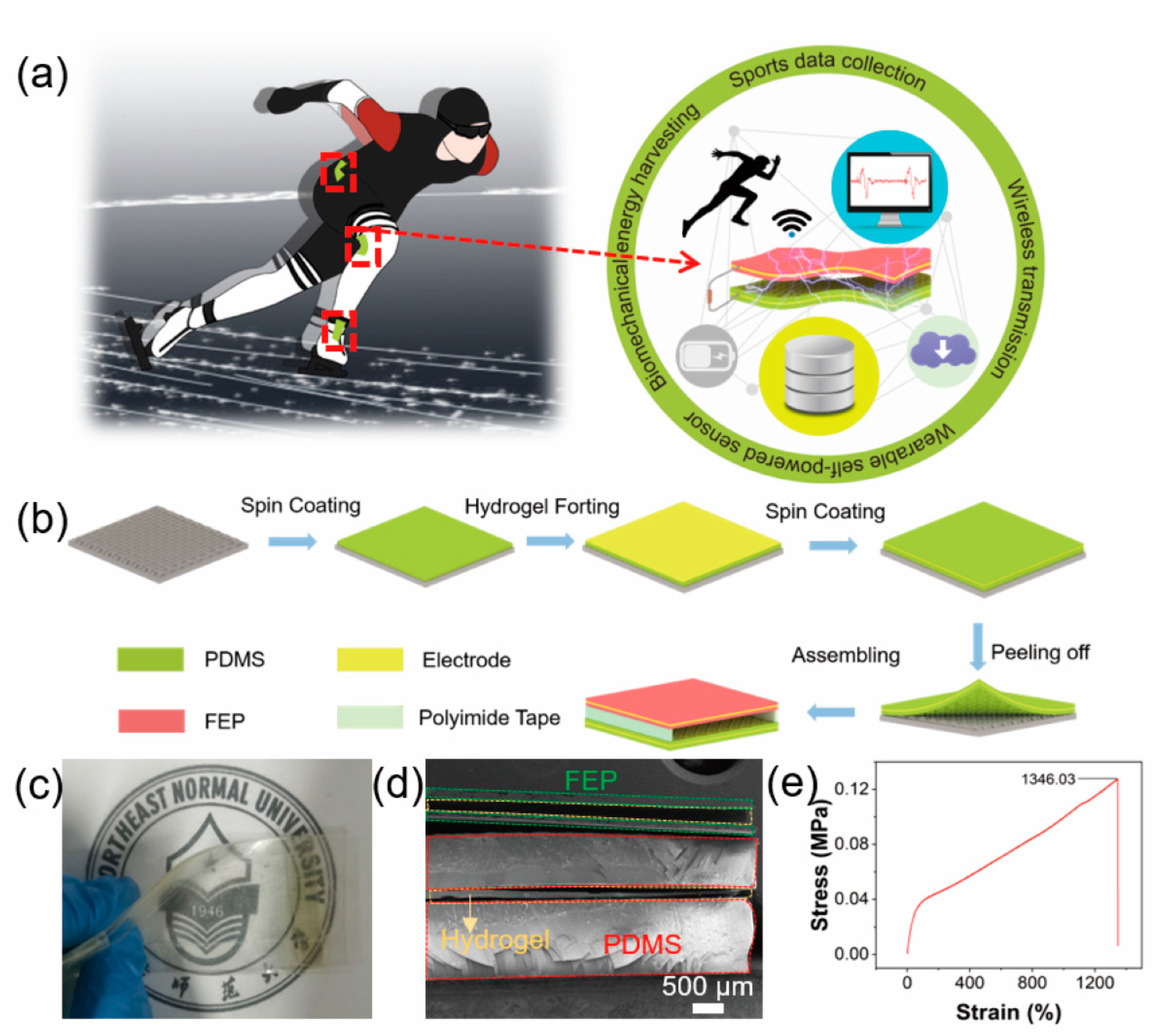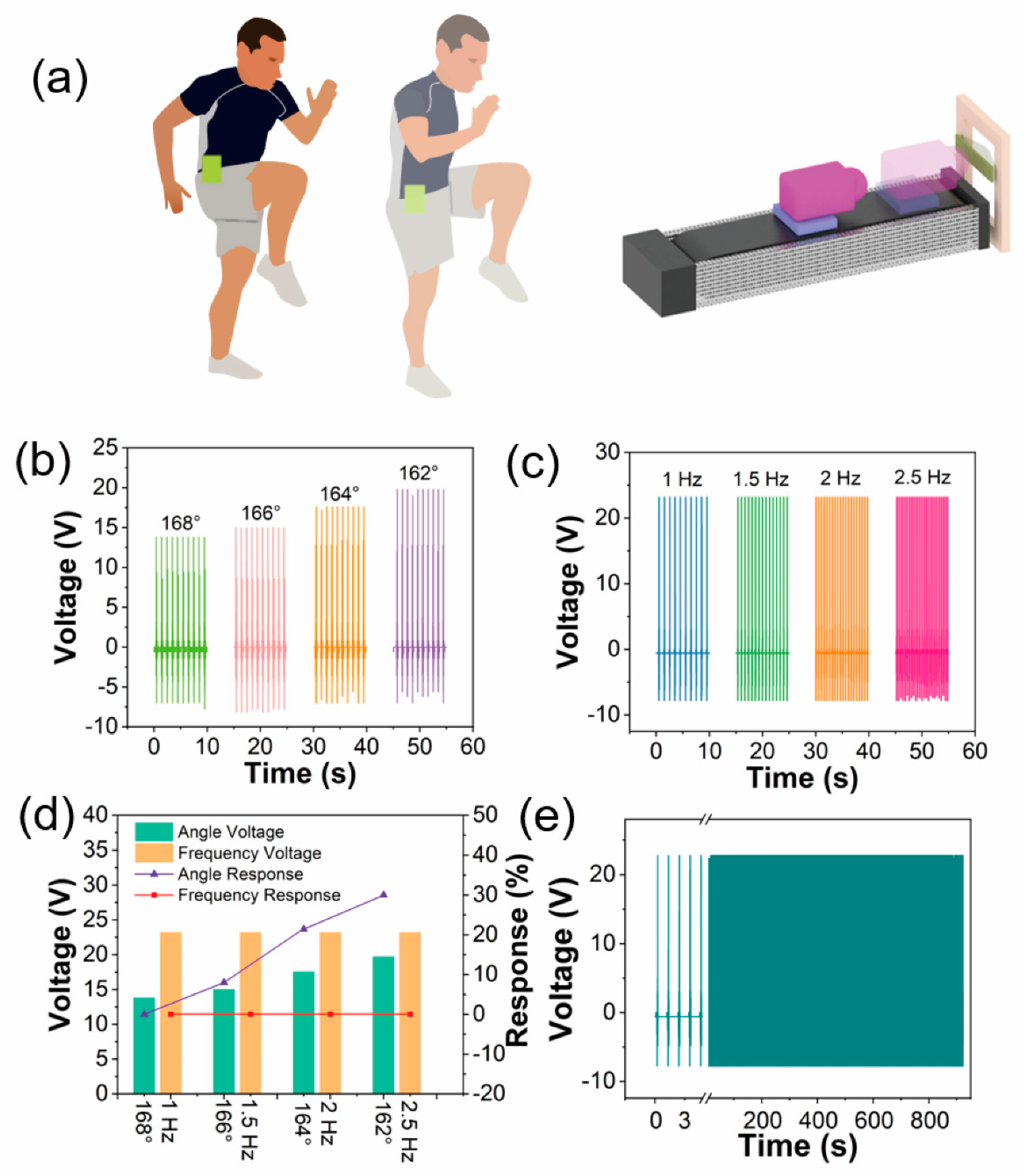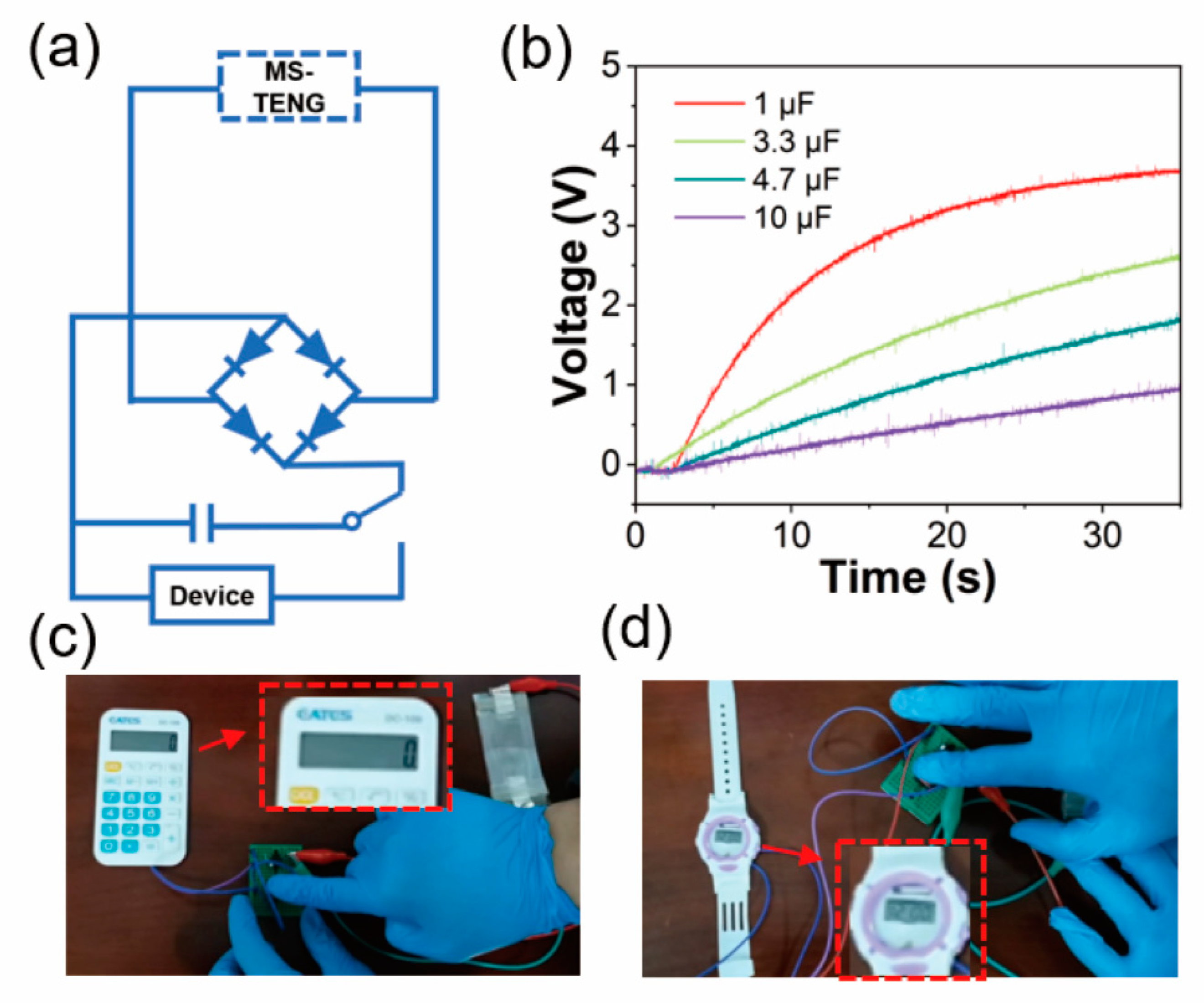A Flexible TENG Based on Micro-Structure Film for Speed Skating Techniques Monitoring and Biomechanical Energy Harvesting
Abstract
:1. Introduction
2. Materials and Methods
2.1. Materials
2.2. Methods
2.3. Characterization and Measurement
3. Results and Discussion
4. Conclusions
Supplementary Materials
Author Contributions
Funding
Institutional Review Board Statement
Informed Consent Statement
Data Availability Statement
Acknowledgments
Conflicts of Interest
References
- Spiteri, T.; McIntyre, F.; Specos, C.; Myszka, S. Cognitive Training for Agility: The Integration Between Perception and Action. Strength Cond. J. 2018, 40, 39–46. [Google Scholar] [CrossRef]
- Guimaraes, E.; Baxter-Jones, A.D.G.; Williams, A.M.; Tavares, F.; Janeira, M.A.; Maia, J. Tracking Technical Skill Development in Young Basketball Players: The INEX Study. Int. J. Environ. Res. Public Health 2021, 18, 4094. [Google Scholar] [CrossRef] [PubMed]
- Alesi, M.; Bianco, A.; Luppina, G.; Palma, A.; Pepi, A. Improving Children’s Coordinative Skills and Executive Functions: The Effects of a Football Exercise Program. Percept. Mot. Ski. 2016, 122, 27–46. [Google Scholar] [CrossRef] [PubMed]
- Liang, Y.P.; Kuo, Y.L.; Hsu, H.C.; Hsia, Y.Y.; Hsu, Y.W.; Tsai, Y.J. Collegiate baseball players with more optimal functional movement patterns demonstrate better athletic performance in speed and agility. J. Sport Sci 2019, 37, 544–552. [Google Scholar] [CrossRef] [PubMed]
- Schwesig, R.; Laudner, K.G.; Delank, K.S.; Brill, R.; Schulze, S. Relationship between Ice Hockey-Specific Complex Test (IHCT) and Match Performance. Appl. Sci. 2021, 11, 3080. [Google Scholar] [CrossRef]
- Slater, L.V.; Vriner, M.; Zapalo, P.; Arbour, K.; Hart, J.M. Difference in Agility, Strength, and Flexibility in Competitive Figure Skaters Based on Level of Expertise and Skating Discipline. J. Strength Cond. Res. 2016, 30, 3321–3328. [Google Scholar] [CrossRef]
- Oguchi, T.; Ae, M.; Schwameder, H. Step characteristics of international-level skeleton athletes in the starting phase of official races. Sports Biomech. 2021, 1–14, online ahead of print. [Google Scholar] [CrossRef]
- Kim, K.; Kim, J.S.; Purevsuren, T.; Khuyagbaatar, B.; Lee, S.; Kim, Y.H. New method to evaluate three-dimensional push-off angle during short-track speed skating using wearable inertial measurement unit sensors. Proc. Inst. Mech. Eng. Part H J. Eng. Med. 2019, 233, 476–480. [Google Scholar] [CrossRef]
- Tomita, Y.; Iizuka, T.; Irisawa, K.; Imura, S. Detection of Movement Events of Long-Track Speed Skating Using Wearable Inertial Sensors. Sensors 2021, 21, 3649. [Google Scholar] [CrossRef]
- Purevsuren, T.; Khuyagbaatar, B.; Kim, K.; Kim, Y.H. Investigation of Knee Joint Forces and Moments during Short-Track Speed Skating Using Wearable Motion Analysis System. Int. J. Precis Eng. Man 2018, 19, 1055–1060. [Google Scholar]
- Wang, Z.L. On Maxwell’s displacement current for energy and sensors: The origin of nanogenerators. Mater. Today 2017, 20, 74–82. [Google Scholar] [CrossRef]
- Niu, S.M.; Wang, S.H.; Lin, L.; Liu, Y.; Zhou, Y.S.; Hu, Y.F.; Wang, Z.L. Theoretical study of contact-mode triboelectric nanogenerators as an effective power source. Energy Environ. Sci. 2013, 6, 3576–3583. [Google Scholar] [CrossRef]
- Liu, Y.; Niu, S.M.; Wang, Z.L. Theory of Tribotronics. Adv. Electron. Mater. 2015, 1, 1500124. [Google Scholar] [CrossRef]
- Li, X.J.; Luo, J.J.; Han, K.; Shi, X.; Ren, Z.W.; Xi, Y.; Ying, Y.B.; Ping, J.F.; Wang, Z.L. Stimulation of ambient energy generated electric field on crop plant growth. Nat. Food 2022, 3, 133–142. [Google Scholar] [CrossRef]
- Wu, C.S.; Wang, A.C.; Ding, W.B.; Guo, H.Y.; Wang, Z.L. Triboelectric Nanogenerator: A Foundation of the Energy for the New Era. Adv. Energy Mater. 2019, 9, 1802906. [Google Scholar] [CrossRef]
- Wang, Z.L. Triboelectric Nanogenerator (TENG)-Sparking an Energy and Sensor Revolution. Adv. Energy Mater. 2020, 10, 2000137. [Google Scholar] [CrossRef] [Green Version]
- Zhao, T.M.; Fu, Y.M.; Sun, C.X.; Zhao, X.S.; Jiao, C.X.; Du, A.; Wang, Q.; Mao, Y.P.; Liu, B.D. Wearable biosensors for real-time sweat analysis and body motion capture based on stretchable fiber-based triboelectric nanogenerators. Biosens. Bioelectron. 2022, 205, 114115. [Google Scholar] [CrossRef]
- Lu, Z.; Zhu, Y.S.; Jia, C.J.; Zhao, T.M.; Bian, M.Y.; Jia, C.F.; Zhang, Y.Q.; Mao, Y.P. A Self-Powered Portable Flexible Sensor of Monitoring Speed Skating Techniques. Biosensors 2021, 11, 108. [Google Scholar] [CrossRef]
- Mao, Y.P.; Yue, W.; Zhao, T.M.; Shen, M.L.; Liu, B.; Chen, S. A Self-Powered Biosensor for Monitoring Maximal Lactate Steady State in Sport Training. Biosensors 2020, 10, 75. [Google Scholar] [CrossRef]
- Yoo, D.; Go, E.Y.; Choi, D.; Lee, J.W.; Song, I.; Sim, J.Y.; Hwang, W.; Kim, D.S. Increased Interfacial Area between Dielectric Layer and Electrode of Triboelectric Nanogenerator toward Robustness and Boosted Energy Output. Nanomaterials 2019, 9, 71. [Google Scholar] [CrossRef] [Green Version]
- Ding, Z.Y.; Zou, M.; Yao, P.; Zhu, Z.Y.; Fan, L. A Triboelectric Nanogenerator Based on Sodium Chloride Powder for Self-Powered Humidity Sensor. Nanomaterials 2021, 11, 2657. [Google Scholar] [CrossRef] [PubMed]
- Chen, H.M.; Xu, Y.; Zhang, J.S.; Wu, W.T.; Song, G.F. Self-Powered Flexible Blood Oxygen Monitoring System Based on a Triboelectric Nanogenerator. Nanomaterials 2019, 9, 778. [Google Scholar] [CrossRef] [PubMed] [Green Version]
- Tofel, P.; Castkova, K.; Riha, D.; Sobola, D.; Papez, N.; Kastyl, J.; Talu, S.; Hadas, Z. Triboelectric Response of Electrospun Stratified PVDF and PA Structures. Nanomaterials 2022, 12, 349. [Google Scholar] [CrossRef]
- Zi, Y.L.; Guo, H.Y.; Wen, Z.; Yeh, M.H.; Hu, C.G.; Wang, Z.L. Harvesting Low-Frequency (<5 Hz) Irregular Mechanical Energy: A Possible Killer Application of Triboelectric Nanogenerator. ACS Publ. 2016, 10, 4797–4805. [Google Scholar]
- Pu, X.; Liu, M.M.; Chen, X.Y.; Sun, J.M.; Du, C.H.; Zhang, Y.; Zhai, J.Y.; Hu, W.G.; Wang, Z.L. Ultrastretchable, transparent triboelectric nanogenerator as electronic skin for biomechanical energy harvesting and tactile sensing. Sci. Adv. 2017, 3, e1700015. [Google Scholar] [CrossRef] [PubMed]
- Lu, X.; Zheng, L.; Zhang, H.D.; Wang, W.H.; Wang, Z.L.; Sun, C.W. Stretchable, transparent triboelectric nanogenerator as a highly sensitive self-powered sensor for driver fatigue and distraction monitoring. Nano Energy 2020, 78, 105359. [Google Scholar] [CrossRef]
- Jing, X.; Li, H.; Mi, H.Y.; Feng, P.Y.; Tao, X.M.; Liu, Y.J.; Liu, C.T.; Shen, C.Y. Enhancing the Performance of a Stretchable and Transparent Triboelectric Nanogenerator by Optimizing the Hydrogel Ionic Electrode Property. ACS Appl. Mater. Inter. 2020, 12, 23474–23483. [Google Scholar] [CrossRef]
- Wang, C.; Qu, X.C.; Zheng, Q.; Liu, Y.; Tan, P.C.A.; Shi, B.J.; Ouyang, H.; Chao, S.Y.; Zou, Y.; Zhao, C.C.; et al. Stretchable, Self-Healing, and Skin-Mounted Active Sensor for Multipoint Muscle Function Assessment. ACS Nano 2021, 15, 10130–10140. [Google Scholar] [CrossRef]
- Zhu, Y.S.; Sun, F.X.; Jia, C.J.; Zhao, T.M.; Mao, Y.P. A Stretchable and Self-Healing Hybrid Nano-Generator for Human Motion Monitoring. Nanomaterials 2022, 12, 104. [Google Scholar] [CrossRef]
- Wang, C.H.; Li, X.S.; Hu, H.J.; Zhang, L.; Huang, Z.L.; Lin, M.Y.; Zhang, Z.R.; Yin, Z.N.; Huang, B.; Gong, H.; et al. Monitoring of the central blood pressure waveform via a conformal ultrasonic device. Nat. Biomed. Eng. 2018, 2, 687–695. [Google Scholar] [CrossRef]
- Shin, J.H.; Yan, Y.; Bai, W.B.; Xue, Y.G.; Gamble, P.; Tian, L.M.; Kandela, I.; Haney, C.R.; Spees, W.; Lee, Y.; et al. Bioresorbable pressure sensors protected with thermally grown silicon dioxide for the monitoring of chronic diseases and healing processes. Nat. Biomed. Eng. 2019, 3, 37–46. [Google Scholar] [CrossRef] [PubMed]
- Chen, Z.S.; Yu, J.H.; Xu, M.F.; Zeng, H.Z.; Tao, K.; Wu, Z.X.; Wu, J.; Miao, J.M.; Chang, H.L.; Yuan, W.Z. Highly Deformable and Transparent Triboelectric Physiological Sensor Based on Anti-Freezing and Anti-Drying Ionic Conductive Hydrogel. In Proceedings of the 34th IEEE International Conference on Micro Electro Mechanical Systems (MEMS), Electr network, 25–29 January 2021. [Google Scholar]
- Han, X.; Jiang, D.J.; Qu, X.C.; Bai, Y.; Cao, Y.; Luo, R.Z.; Li, Z. A Stretchable, Self-Healable Triboelectric Nanogenerator as Electronic Skin for Energy Harvesting and Tactile Sensing. Materials 2021, 14, 1689. [Google Scholar] [CrossRef] [PubMed]
- Jiang, B.; Long, Y.; Pu, X.; Hu, W.G.; Wang, Z.L. A stretchable, harsh condition-resistant and ambient-stable hydrogel and its applications in triboelectric nanogenerator. Nano Energy 2021, 86, 106086. [Google Scholar] [CrossRef]
- Zhao, G.R.; Zhang, Y.W.; Shi, N.; Liu, Z.R.; Zhang, X.D.; Wu, M.Q.; Pan, C.F.; Liu, H.L.; Li, L.L.; Wang, Z.L. Transparent and stretchable triboelectric nanogenerator for self-powered tactile sensing. Nano Energy 2019, 59, 302–310. [Google Scholar] [CrossRef]
- Yu, J.B.; Hou, X.J.; He, J.; Cui, M.; Wang, C.; Geng, W.P.; Mu, J.L.; Han, B.; Chou, X.J. Ultra-flexible and high-sensitive triboelectric nanogenerator as electronic skin for self-powered human physiological signal monitoring. Nano Energy 2020, 69, 104437. [Google Scholar] [CrossRef]
- Su, Y.J.; Chen, C.X.; Pan, H.; Yang, Y.; Chen, G.R.; Zhao, X.; Li, W.X.; Gong, Q.C.; Xie, G.Z.; Zhou, Y.H.; et al. Muscle Fibers Inspired High-Performance Piezoelectric Textiles for Wearable Physiological Monitoring. Adv. Funct. Mater. 2021, 31, 2010962. [Google Scholar] [CrossRef]
- Cho, D.; Li, R.; Jeong, H.; Li, S.P.; Wu, C.S.; Tzavelis, A.; Yoo, S.; Kwak, S.S.; Huang, Y.G.; Rogers, J.A. Bitter Flavored, Soft Composites for Wearables Designed to Reduce Risks of Choking in Infants. Adv. Mater. 2021, 33, 2103857. [Google Scholar] [CrossRef]
- Sriphan, S.; Vittayakorn, N. Facile roughness fabrications and their roughness effects on electrical outputs of the triboelectric nanogenerator. Smart Mater. Struct. 2018, 27, 105026. [Google Scholar] [CrossRef]
- Kim, K.N.; Lee, J.P.; Lee, S.H.; Lee, S.C.; Baik, J.M. Ergonomically designed replaceable and multifunctional triboelectric nanogenerator for a uniform contact. RSC Adv. 2016, 6, 88526–88530. [Google Scholar] [CrossRef]
- Park, H.J.; Jeong, J.M.; Son, S.G.; Kim, S.G.; Lee, M.; Kim, S.J.; Jeong, J.; Hwang, S.Y.; Park, J.; Eom, Y.; et al. Fluid-Dynamics-Processed Highly Stretchable, Conductive, and Printable Graphene Inks for Real-Time Monitoring Sweat during Stretching Exercise. Adv. Funct. Mater. 2021, 31, 2011059. [Google Scholar] [CrossRef]
- Deng, W.; Yang, T.; Jin, L.; Yan, C.; Huang, H.; Chu, X.; Wang, Z.; Xiong, D.; Tian, G.; Gao, Y.; et al. Cowpea-structured PVDF/ZnO nanofibers based flexible self-powered piezoelectric bending motion sensor towards remote control of gestures. Nano Energy 2019, 55, 516–525. [Google Scholar] [CrossRef]
- He, M.; Du, W.; Feng, W.; Li, S.; Wang, W.; Zhang, X.; Yu, A.; Wan, L.; Zhai, J. Flexible and stretchable triboelectric nanogenerator fabric for biomechanical energy harvesting and self-powered dual-mode human motion monitoring. Nano Energy 2021, 86, 106058. [Google Scholar] [CrossRef]
- Wang, L.; Liu, W.; Yan, Z.; Wang, F.; Wang, X. Stretchable and Shape-Adaptable Triboelectric Nanogenerator Based on Biocompatible Liquid Electrolyte for Biomechanical Energy Harvesting and Wearable Human–Machine Interaction. Adv. Funct. Mater. 2021, 31, 2007221. [Google Scholar] [CrossRef]
- Li, G.; Deng, Z.H.; Cai, M.K.; Huang, K.X.; Guo, M.X.; Zhang, P.; Hou, X.Y.; Zhang, Y.; Wang, Y.J.; Wang, Y.; et al. A stretchable and adhesive ionic conductor based on polyacrylic acid and deep eutectic solvents. Npj Flex. Electron. 2021, 5, 23. [Google Scholar] [CrossRef]
- Norioka, C.; Inamoto, Y.; Hajime, C.; Kawamura, A.; Miyata, T. A universal method to easily design tough and stretchable hydrogels. Npg Asia Mater. 2021, 13, 34. [Google Scholar] [CrossRef]
- Schulz, V.; Zschoche, S.; Zhang, H.P.; Voit, B.; Gerlach, G. Macroporous Smart Hydrogels for Fast-responsive Piezoresistive Chemical Microsensors. In Proceedings of the 25th Eurosensors Conference, Athens, Greece, 4–7 September 2011. [Google Scholar]
- Erfkamp, J.; Guenther, M.; Gerlach, G. Piezoresistive Hydrogel-Based Sensors for the Detection of Ammonia. Sensors 2019, 19, 971. [Google Scholar] [CrossRef] [Green Version]
- Erfkamp, J.; Guenther, M.; Gerlach, G. Enzyme-Functionalized Piezoresistive Hydrogel Biosensors for the Detection of Urea. Sensors 2019, 19, 2858. [Google Scholar] [CrossRef] [Green Version]
- Zhao, T.M.; Wang, Q.; Du, A. Self-Powered Flexible Sour Sensor for Detecting Ascorbic Acid Concentration Based on Triboelectrification/Enzymatic-Reaction Coupling Effect. Sensors 2021, 21, 373. [Google Scholar] [CrossRef]





| Athlete 1 | Athlete 2 | |
|---|---|---|
| Average voltage of ankle | 3.28 V | 1.78 V |
| Variance of ankle voltage | 4.817 | 0.203 |
| Average voltage of knee | 4.17 V | 0.62 V |
| Variance of knee voltage | 0.555 | 0.0135 |
| Average voltage of coxa | 0.9 V | 0.45 V |
| Variance of coxa voltage | 0.168 | 0.002 |
Publisher’s Note: MDPI stays neutral with regard to jurisdictional claims in published maps and institutional affiliations. |
© 2022 by the authors. Licensee MDPI, Basel, Switzerland. This article is an open access article distributed under the terms and conditions of the Creative Commons Attribution (CC BY) license (https://creativecommons.org/licenses/by/4.0/).
Share and Cite
Lu, Z.; Jia, C.; Yang, X.; Zhu, Y.; Sun, F.; Zhao, T.; Zhang, S.; Mao, Y. A Flexible TENG Based on Micro-Structure Film for Speed Skating Techniques Monitoring and Biomechanical Energy Harvesting. Nanomaterials 2022, 12, 1576. https://doi.org/10.3390/nano12091576
Lu Z, Jia C, Yang X, Zhu Y, Sun F, Zhao T, Zhang S, Mao Y. A Flexible TENG Based on Micro-Structure Film for Speed Skating Techniques Monitoring and Biomechanical Energy Harvesting. Nanomaterials. 2022; 12(9):1576. https://doi.org/10.3390/nano12091576
Chicago/Turabian StyleLu, Zhuo, Changjun Jia, Xu Yang, Yongsheng Zhu, Fengxin Sun, Tianming Zhao, Shouwei Zhang, and Yupeng Mao. 2022. "A Flexible TENG Based on Micro-Structure Film for Speed Skating Techniques Monitoring and Biomechanical Energy Harvesting" Nanomaterials 12, no. 9: 1576. https://doi.org/10.3390/nano12091576
APA StyleLu, Z., Jia, C., Yang, X., Zhu, Y., Sun, F., Zhao, T., Zhang, S., & Mao, Y. (2022). A Flexible TENG Based on Micro-Structure Film for Speed Skating Techniques Monitoring and Biomechanical Energy Harvesting. Nanomaterials, 12(9), 1576. https://doi.org/10.3390/nano12091576









